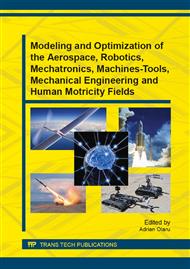[1]
A. F. Kahraman, A. Gosavi, K. J. Oty: Stochastic Modeling of an Automated Guided Vehicle System With One Vehicle and a Closed-Loop Path. IEEE Transactions on Automation Science and Engineering, Vol. 5, No. 3, July (2008).
DOI: 10.1109/tase.2008.917015
Google Scholar
[2]
K. -C. Ko, P. J. Egbelu: Unidirectional AGV guidepath network design: a heuristic algorithm. International Journal of Production Research, Vol. 41, No. 10, (2003), pp.2325-2343.
DOI: 10.1080/0020754031000087201
Google Scholar
[3]
T. Le-Anh, M.B.M. De Koster: A review of design and control of automated guided vehicle systems. European Journal of Operational Research, Vol. 171, (2006), p.1–23.
DOI: 10.1016/j.ejor.2005.01.036
Google Scholar
[4]
T. Le-Anh, M.B.M. De Koster: Multi-Attribute Dispatching Rules For AGV Systems With Many Vehicles, http: /repub. eur. nl/res/pub/1809/ERS 2004 077 LIS. pdf.
Google Scholar
[5]
A. Osyczka, S. Krenich: Evolutionary Algorithms for Global Optimization, Chapter in J. Pinter (Ed. ) Global Optimization – Scientific and Engineering Case Studies. Springer, 2006, pp.267-300.
Google Scholar
[6]
L. Qiu, W. Hsu, S. Huang, H. Wang: Scheduling and routing algorithms for AGVs: A survey. International Journal of Production Research, Vol. 40, No. 3, (2002), p.745–760.
DOI: 10.1080/00207540110091712
Google Scholar
[7]
S. Reveliotis: Conflict resolution in AGV systems. IIE Transactions, Vol. 32, No. 7, (2000), pp.647-659.
DOI: 10.1080/07408170008967423
Google Scholar
[8]
S. Takakuwa: Design and Cost-Effectiveness Analysis of Large-Scale AS/RS-AGV Systems. Proceedings of the 1993 Winter Simulation Conference.
DOI: 10.1109/wsc.1993.718329
Google Scholar
[9]
I.F.A. Vis, R. de Koster, K.J. Roodbergen, L.W.P. Peeters: Determination of the number of automated guided vehicles required at a semi-automated container terminal. Journal of the Operational Research Society, Vol. 52, (2001), p.409–417.
DOI: 10.1057/palgrave.jors.2601094
Google Scholar
[10]
J. Zając, G. Chwajoł: Koncepcja integracji rozproszonego systemu sterowania produkcją AIM z podsystemem transportu międzyoperacyjnego zbudowanym z autonomicznych robotów mobilnych, PAR, Nr 2, (2011), s. 392-401.
DOI: 10.15199/148.2018.12.2
Google Scholar


